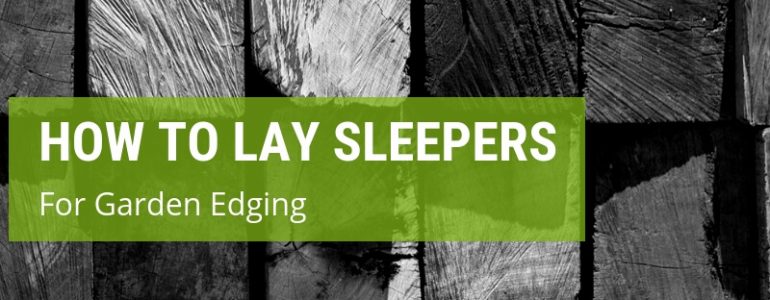Sleepers provide an easy and practical way to define the edge of your garden.
You can use them to prevent mulch and soil from spilling onto pathways or the lawn and ensure no one accidentally walks on the garden.
Sleepers also enhance your outdoor aesthetics. They highlight the garden area, creating a beautiful contrast to the rest of the yard.
You can also use sleepers to make pathways stand out more.
Laying down sleepers for garden edging is a fairly simply DIY project. You only need basic tools and a couple of hours, or more depending on how big your garden is.
Here’s how to go about it – how to lay sleepers for garden edging.
How to lay sleepers for garden edging
1. Choose a location
If you already have a garden, you just need to outline the edges where you’ll lay the sleepers.
If you are starting from scratch, the first step is to figure out where you want to locate the bed. Normally, the best place is on the edge of the lawn.
This protects your garden from human traffic as well as pets.
But you can also locate it within your yard but make it a raised bed. You’ll have to make a higher retaining wall with the sleepers to keep the garden contained.
2. Gather tools and materials
Here are the basic tools and materials you’ll need for the project.
- Spirit level
- Saw
- Sleeper screws or brackets
- 200mm x 100mm railway sleepers (new not reclaimed)
- Screw driver
- Retaining posts
3. Dig a shallow trench and prepare the foundation
To keep the sleepers secure in the ground, dig a shallow trench where you’ll prepare the foundation.
You have several options when it comes to foundation. Concrete is the best. It keeps the sleepers stable especially if you plan on having more than one layer.
If preparing a concrete foundation is too much work, you can also use gravel or sand. These are great for draining. They also make levelling the sleepers much easier.
You can also place the sleepers directly on the soil but you might have issues with water pooling around the edges, causing the wood to rot quicker.
If you decide to lay them directly on soil, put down a waterproof plastic membrane first to reduce contact with moisture.
4. Lay the sleepers
For edging of a level bed, one or two layers of sleepers is more than enough to separate the garden from the yard.
If it’s a raised garden, you’ll need a higher retaining wall, meaning more sleeper layers.
There are two ways to lay down the sleepers: on their wide side or on their narrow side.
If you use the narrow side and stack two or more sleeper layers, you’ll need retaining posts on the sides to stabilise the edging.
You may need to cut the sleepers to the right size depending on the length and shape of your bed. Use a crosscut saw, a circular saw or a mitre saw.
Lay down the sleepers, making sure they overlap on their ends to form a 90-degree corner. Use the spirit level to make sure each sleeper is level. In the end, you should have something like a picture frame.
If you want something a bit neater, use a mitre saw to make mitred joints at each corner.
Fasten the sleepers together by securing sleeper screws at the 90-degree corners. Use two screws per corner to get a rigid frame. You can also use corner brackets to secure the sleepers.
If you want a higher edging, add another layer of sleepers on top and secure it to the bottom layer using sleeper screws.
Remember to use retaining posts if you’ve used the narrower side of the sleepers.
5. Fill with soil
When you’ve achieved the perfect height, you can go ahead and add soil and compost to your garden and plant whatever you want.
Monitor the edging carefully to make sure it stays stable and does not let soil run out beyond the garden.
Also check that the edging allows proper drainage.
A note on buying sleepers
A few years ago, most gardeners used reclaimed sleeper from railway lines.
But there is no need to do so no. You can easily get good quality and affordable new sleepers online or at a local store.
The problem with most reclaimed sleepers is that they’ve been treated. There is a risk that those chemicals might leak into your soil and affect the health and safety of your plants.






Hi Jack, great article, thanks. As a first timer using sleepers, how deep would you recommend for the trench. I am going to use a single layer of sleepers on their widest side. It’ll be used to separate a path onto a gravelled area, so immediately onto the sleepers will be soil, membrane and topped with decorative gravel. Thanks in advance. Stay safe, Ginny